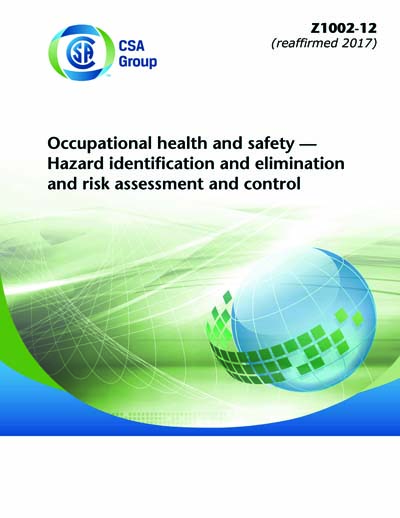Most recent
CSA Z1002-12 (R2022)
Occupational health and safety - Hazard identification and elimination and risk assessment and control
Preface This is the first edition of CSA Z1002, Occupational health and safety — Hazard identification and elimination and risk assessment and control. This Standard is part of the CSA Z1000 series of occupational health and safety management Standards. This Standard describes methods that can be used to identify hazards, eliminate hazards, and analyze the risk associated with hazards that cannot be eliminated. It also provides guidance on the application of risk control measures, monitoring of residual risk, and continual improvement to reduce the risk as better risk control measures become available. The information presented in this Standard is suitable for use in all sectors and applications. Other Standards that address risk assessment and control methodologies for specific sectors and/or applications might exist. The information in this Standard should be used with those Standards and tailored to meet their specific needs. This Standard was developed to address the need for common terminology and processes that can apply to all types of occupational health and safety (OHS) hazards and risks. It was the intent of the Technical Committee to harmonize this Standard, where possible and appropriate, with international Standards. This Standard was developed using ISO 14121-1:2007, Safety of machinery — Risk assessment — Part 1: Principles, and ISO/TR 14121-2:2007, Safety of machinery — Risk assessment — Part 2: Practical guidance and examples of methods, as the seed documents. It aligns with the following national Standards to enable integration with other governance and management systems: (a) CAN/CSA-ISO 31000-10, Risk management — Principles and guidelines; (b) CAN/CSA-ISO/IEC 31010-10, Risk management — Risk assessment techniques; and (c) CAN/CSA-Z1000-06, Occupational health and safety management. There are over one hundred models for risk assessment. The terms used for risk assessment, and their interpretation, vary across disciplines, applications, and jurisdictions. These models and terms are often used by organizations to prioritize which actions will be taken, if any. The application of these models and terms is highly dependent on the perspective from which risk is viewed (who are making decisions, which parameters and tools they are using, and for what reasons). It is generally recognized that the effects of worker fatalities, injuries, and illnesses on our society and our economy are substantial. This Standard focuses on effectively reducing risk rather than tolerating or accepting risk. After diligent review of legislation, standards, guidelines, and other documentation, the Technical Committee agreed that tolerating and accepting risks that can be eliminated or effectively reduced is not acceptable from a societal or economic point of view. The Technical Committee agreed to take a fundamental approach to risk assessment that focuses on prevention of harm and protection of workers and can be applied to any type of OHS risk at any stage in the lifecycle of a product, process, or service. The focus on hazard identification and elimination and effective control of risks from hazards that cannot be eliminated is the keystone of this Standard. Eliminating a hazard eliminates risks associated with that hazard. Not all hazards can be eliminated. There will be some level of risk where hazards remain. This Standard requires application of the hierarchy of risk controls throughout the lifecycle of a product, process, or service to effectively control the risk so that workers are protected from harm. This Standard also requires ongoing actions to ensure the continuing effectiveness of the applied controls. This Standard was developed with support from federal, provincial, and territorial OHS government agencies. This Standard was prepared by the Technical Committee on Injury Risk Assessment and Management, under the jurisdiction of the Strategic Steering Committee on Occupational Health and Safety, and has been formally approved by the Technical Committee. This Standard has been developed in compliance with Standards Council of Canada requirements for National Standards of Canada. It has been published as a National Standard of Canada by CSA Group. Scope 1.1 General This Standard specifies requirements for the identification of OHS hazards, their elimination where practical, and assessment and control of risks associated with remaining hazards. 1.2 Applicability This Standard is applicable to organizations of any size or type and can be applied at all stages in the lifecycle of a product, process, or service. 1.3 Use This Standard is intended to be used by all stakeholders, e.g., those who are responsible for (a) evaluating an organization's practices in assessing OHS risk; (b) ensuring that an organization eliminates OHS hazards and controls risk associated with remaining hazards that cannot be eliminated; (c) organizational efforts to eliminate OHS hazards and control risk associated with a specific area or activity; and (d) development of standards, guides, procedures, and codes of practice that in whole or in part set out how hazards are to be eliminated and risks controlled within the specific context of their documents. 1.4 Terminology In this Standard, "shall" is used to express a requirement, i.e., a provision that the user is obliged to satisfy in order to comply with the standard; "should" is used to express a recommendation or that which is advised but not required; and "may" is used to express an option or that which is permissible within the limits of the standard. Notes accompanying clauses do not include requirements or alternative requirements; the purpose of a note accompanying a clause is to separate from the text explanatory or informative material. Notes to tables and figures are considered part of the table or figure and may be written as requirements. Annexes are designated normative (mandatory) or informative (nonmandatory) to define their application.
Content Provider
CSA America, Inc. [csa]






